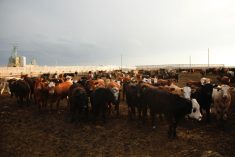Compared to last week, western Canadian yearlings were $2-$3 higher; calf prices were $2 to as much as $4 higher; calves under 600 lbs. were $4 to as much as $10 higher in some cases.
February and April live cattle futures appear to be incorporating a risk premium due to the uncertainty in beef production during the first quarter of 2020. Feeding margins are still hovering in negative territory in the short term; however, there appears to be profitability January forward. Packing margins have been favourable and they’re processing as many cattle as they can get their hands on.
Read Also

Alberta crop conditions improve: report
Varied precipitation and warm temperatures were generally beneficial for crop development across Alberta during the week ended July 8, according to the latest provincial crop report released July 11.
Feedlot operators were quick to respond last week, as feeder cattle prices have been rather sluggish throughout November. At this time of year, feeder cattle have adjusted to the winter-type conditions. The deathloss discount that was evident earlier in fall has evaporated. The quality of feeders coming on the market is quite variable but discounts were also negligible on lighter unweaned calves.
Yearling supplies are rather snug at this time of year and February live cattle futures made fresh contract highs last week. Therefore, rejuvenated buying interest surfaced for short-keep replacements, resulting in a firmer tone.
In central Alberta, medium-frame Simmental-based fleshier steers weighing just under 900 lbs. were valued at $186 and mixed heifers of similar quality averaging 975 lbs. were quoted at $162. In east-central Saskatchewan, late-blooming medium-frame fleshier mixed steers averaging 925 lbs. were quoted at $182. Near Lethbridge, buckskin medium- to heavier-flesh heifers weighing 840 lbs. were quoted at $171.
The focus last week was on calves; there was no doubt about it with noted strength in the lighter weight categories. Steers weighing 500-530 lbs. were readily selling over $230 in most cases, about $10 higher than two weeks ago. Southern Alberta was plagued with a severe storm last week which tempered demand from the Lethbridge area. Southern Alberta markets didn’t carry a premium over other regions of Western Canada. In central Alberta, black steers with some preconditioning shots and weighing 525 lbs. were quoted at $234; a feedlot in central Saskatchewan reported Angus-blended steers weighing 510 lbs. were valued at $233 fob the feedlot. In Manitoba, Charolais-based steers averaging 530 lbs. were quoted at $229 while similar-quality heifers weighing 550 lbs. were valued at $187.
The October 2020 feeder cattle contract is trading at a $9 premium to January 2020, which may have contributed to the strength for feeders under 550 lbs. The futures market appears to be concerned about yearling supplies for the fall of 2020; the 2019 U.S. calf crop may be lower than anticipated.
— Jerry Klassen manages the Canadian office of Swiss-based grain trader GAP SA Grains and Produits Ltd. and is president and founder of Resilient Capital, specializing in proprietary commodity futures trading and market analysis. Jerry consults with feedlots on risk management and writes a weekly cattle market commentary. He can be reached at 204-504-8339 or via his website at ResilCapital.com.



















